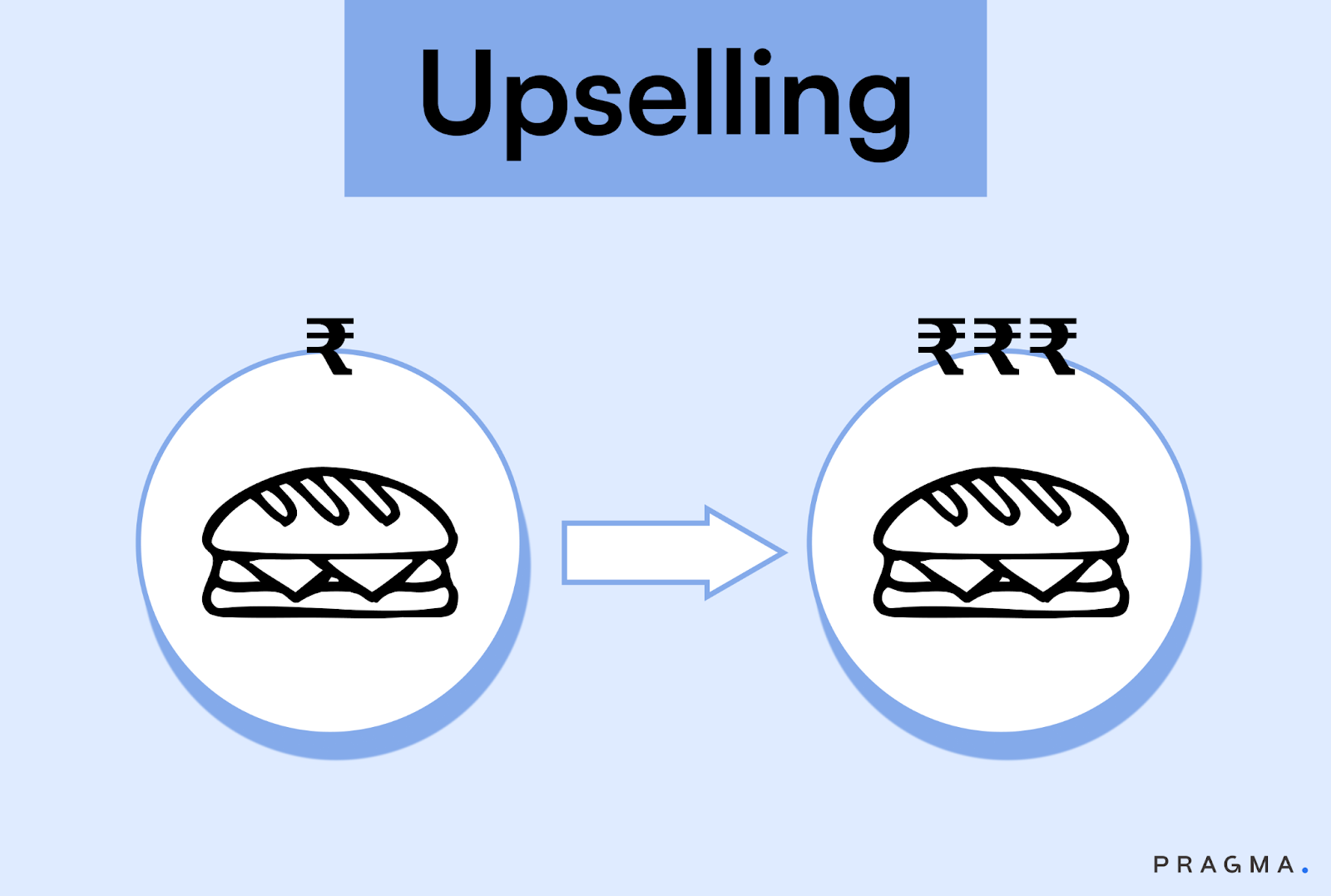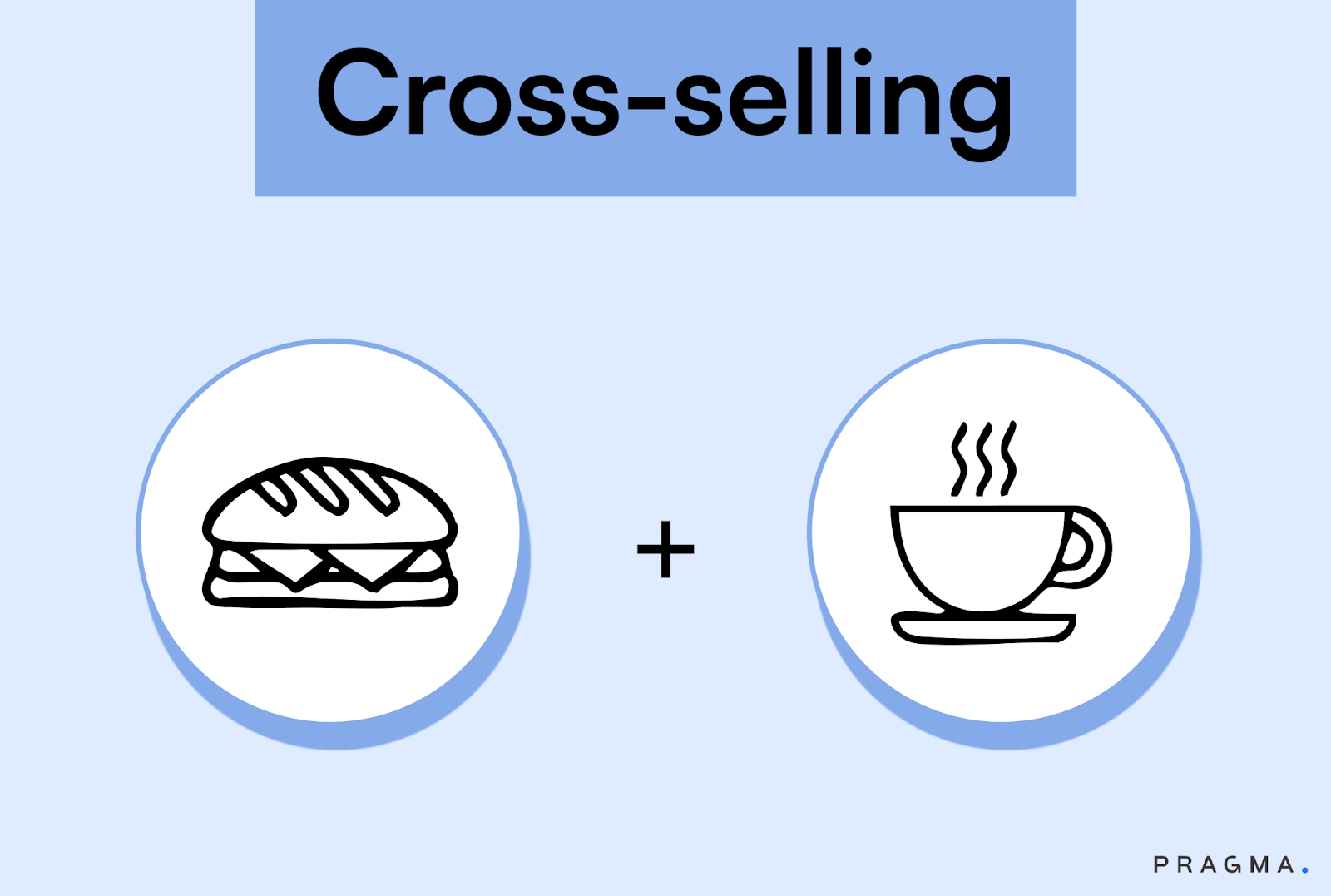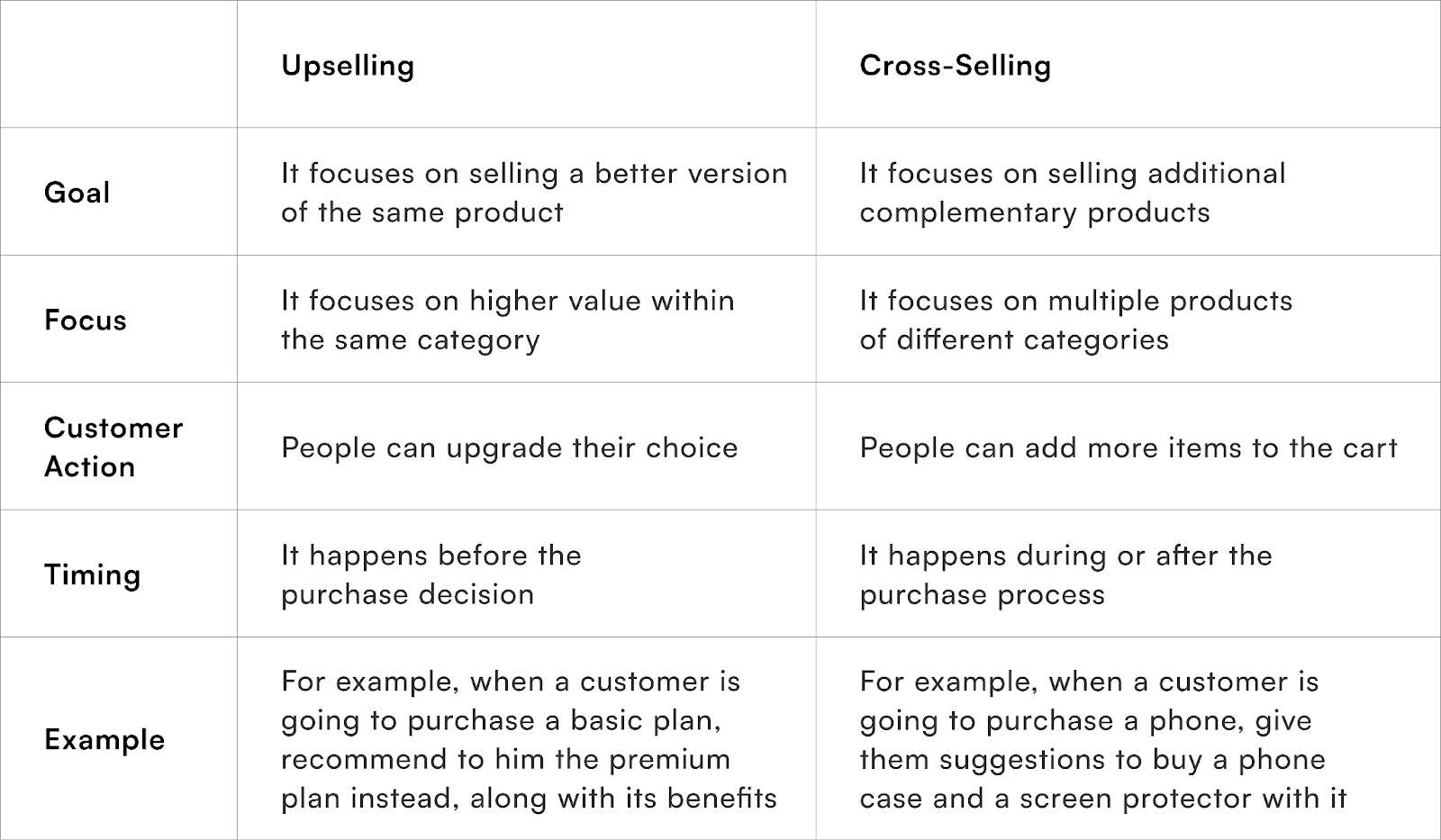In the world of e-commerce, there are thousands of brands in the market, and every brand wants to get huge sales. Although most brands want to attract new customers to increase revenue, what about increasing sales among existing customers?
Yes, many brands are making more of their sales through their existing customers with a technique called Upsell and Cross-Sell.
The upselling and cross-selling initiatives are projected to reach $15.13 billion/ ₹1.26 lakh crore by 2026, growing at a CAGR of 32.4% from 2021 to 2026, according to research. This much growth clearly states how businesses are taking these strategies.
But what exactly are upselling and cross-selling? How are they different? And most importantly, how can you use them to grow your business?
In this blog, we will delve into "Upsell vs Cross-Sell: Key Differences, Benefits & Examples".
What is The Difference Between Cross-Selling and Upselling?
The terms Upsell and Cross-sell seem similar, but they are actually two different strategies that benefit businesses to earn more from their existing customers. So, let us discuss both in detail.
What is Upselling?
Upselling is a sales technique where brands encourage customers to buy the higher-end product. It means that through upselling, they try to sell the more expensive and premium version of their product, in which the customer is already interested.

Upselling of products is always conducted in the same brand that the customer is into. The principle behind the upsell is to shift the customer to the high-value chain by offering them a product in the same category but with better features, quality, or performance.
For example, if someone wants to buy a basic laptop, upselling would be convincing them to buy a laptop with more memory, a faster processor, or a better graphics card for a higher price.
Research from the Journal of Consumer Psychology explains that customers are more likely to consider an upgrade when presented with clear, tangible benefits. That's why the idea that up-selling is beneficial for e-commerce brands.
And for Indian e-commerce brands, to avail this benefit, Pragma helps in upselling the products through 1Checkout
It is an advanced machine learning algorithm system that analyses customer behaviour patterns, purchase history, and real-time browsing data to identify the optimal moments for presenting upsell opportunities.
The platform automatically shows the relevant product suggestions in the same category to the customers while they are about to check out.
What is Cross-Selling?

Cross-selling is a sales technique under which customers are shown other products that are related to or complement their original purchase. These are usually related items that work well together or enhance what the customer is already buying.
Unlike upselling, which focuses on shifting the customer to a higher segment, cross-selling focuses on expanding the customer's purchase by giving them more suggestions related to the product. Cross-selling can be between different brands. It means you can get suggestions for products from various e-commerce brands.
For example, you may have seen that when you are buying a shirt on an online platform, it suggests various other items that complement it. The brand tries to show you how to complete your look. This strategy of showing complementary products falls under cross-selling.
According to Salesforce's State of Sales report, 31% of businesses say that cross-selling and upselling are their primary growth strategies, with cross-selling showing powerful results in building long-term customer relationships. Pragma also helps brands identify the various cross-selling opportunities.
Upsell Vs Cross-Sell: Key Differences Explained

Example of Upsell and Cross-Sell in E-commerce
Let us first talk about upselling!
You might have seen that when you are browsing on Amazon for purchasing a table, you may like a Rs. 3000 table, but Amazon shows you a "Compare with similar items" section, suggesting you better table options at higher prices, showing their benefits.

This strategy of showing better products on e-commerce platforms is an example of upselling products.
Whereas, let's say you are searching for a good camera on Amazon, you like a product and add it to your cart, and then Amazon gets suggesting you memory cards, camera bags, and tripods in the "Frequently bought together" section. This is an example of cross-selling.
What are The Benefits of Upselling and Cross-Selling?
Implementing upselling and cross-selling is beneficial for e-commerce brands. Have a look at some of the benefits:
Increase Average Order Value (AOV)
The most obvious benefit of both strategies is the increase in order value. When you show suggestions of higher-value products or complementary products, both benefit the brands to get more revenue. Research shows that:
- Cross-selling can increase sales by up to 20%
- Upselling can boost revenue by 10-30% per transaction
And Pragma helps brands to acquire this benefit. Pragma's AI-powered recommendation engine analyses customer behaviour in real-time to suggest the most relevant upsells, automatically increasing your AOV without any manual effort.
Brands often combine upselling with smart discounting strategies, especially in India, to increase AOV.
Enhance Customer Experience and Retention
Both upsell and cross-sell help to improve customer satisfaction. When they are done right, the customers also feel good to have the right, relevant suggestions.
Research indicates that 70% of customers are more likely to recommend a company that provides personalised experiences.
Improve Customer Lifetime Value (CLV)
When customers buy more products or higher-value items, they become more valuable over time. Studies show that existing customers are 50% more likely to try new products and spend 31% more compared to new customers.
By tracking customer purchase patterns and preferences, Pragma helps identify the best opportunities to increase CLV through personalised product recommendations.
And this is what Pragma provides: Pragma ensures recommendations are always relevant and timely, using machine learning to understand what each customer actually needs rather than pushing random products.
Real-World Example of Upselling and Best Practices
The success of upselling depends on how the brands understand the customer behaviour. It totally depends on how they grab their patterns, timings, etc. To get good upselling results, it is necessary that it feels natural to the customers, not a forceful sales technique.
Let us have a look at the real-world example of upselling and some of the best practices across various industries.
Netflix's Subscription Tier Strategy
Netflix increases its sales through its tiered subscription model:
- Basic Plan: Standard definition, one screen
- Standard Plan: HD quality, two screens simultaneously
- Premium Plan: 4K Ultra HD, four screens simultaneously
And just this easy strategy provides them with amazing results. Netflix reports that 60% of new subscribers choose the Standard plan over Basic, and 25% of Standard subscribers upgrade to Premium within their first year.
What are The Best Practices to Do Upselling Effectively?
1. Understand Customer Needs First
First of all, you must understand your customer's needs. Never upsell without knowing what the customer is trying to solve. Analyse their behaviour, purchasing patterns, and order histories, then recommend a product.
2. Perfect Timing Strategies
Timing is everything. It is important that brands show the products at the right time to upsell. Three timings can be beneficial when suggesting products:
- Pre-Purchase- Show suggestions when customers are comparing different options.
- During Purchase- You can offer upgrades during the checkout process.
- Post-Purchase- Send upgrade offers after your customers have experienced base product limitations.
Timing also varies by region, which is why many brands use location-based hyper-targeting to show the right product at the right moment
3. Provide Clear Features and Benefits
When you are trying to upsell a product, you must provide the following:
- What does the upgrade include?
- How does it help the customer?
- What result will they achieve?
4. Always Keep the Upsell Simple
Every e-commerce brand should keep this in mind when upselling a product: they should keep it simple. Do not offer too many products, as that confuses the customers. Offer only 1–2 highly relevant upgrades.
5. Add Social Proofs
Reviews are a great source of turning viewers into buyers. Every customer checks for real reviews from customers who have purchased the product. They trust what others choose, and highly-rated products convert better.
Pragma's platform automatically implements these best practices. The system analyses customer behaviour patterns to determine optimal timing and crafts personalised value propositions based on individual customer profiles.
Real-World Example of Cross-selling and Best Practices
A successful real-world example of cross-selling is Amazon. This platform makes use of this technique by using the following:
- "Frequently Bought Together" Section
- "Customers Who Viewed This Also Viewed"
- "Complete the Look"
And with such a successful implementation, they gathered 35% of their sales only from cross-selling of products.

What are The Best Practices to Do Cross-Selling Effectively?
1. Recommend Complementary Products Only
It is very crucial here that you only show those products that are relevant to the original purchase. Showing non-relevant products will create a negative impact.
2. Understand Customer Behaviour & Intent
Analyse browsing history, cart items, preferences, and past orders. Brands can use this data to offer cross-sells that seem related.
3. Present Cross-Sells at the Right Time
Show products at the best time. This can be:
- Product page
- Add-to-cart page
- During checkout
- Post-purchase emails
4. Must Highlight the Product Value
Explain why the recommended item is useful. Like the following:
- Protects your device.
- Improves performance.
- Saves time.
Upsell vs Cross-Sell: When to Use Which?

Upsell Vs Cross-Sell, this is the most asked question: which technique to use when? So, let us help you to know which sales technique can be helpful for your brand.
You should choose upselling when:
- You have clear product tiers like basic, premium, and enterprise.
- The upgrade provides your customers with the obvious additional value.
- The customer shows interest in advanced features.
- The price difference isn't too much.
You should choose cross-selling when:
- You have products in your catalogue that complement your customer's original purchase.
- The customer has already made a purchase decision.
- You want to increase your order frequency.
- The additional products that you will offer will solve the related problems of the customers.
How to Upsell and Cross-Sell? Strategies to Implement Upselling and Cross-Selling
1. Know Your Customers
The foremost thing when you want to upsell or cross-sell is to know about your customers. Every brand should know about its customer preferences, buying patterns, and needs.
Research found that 10-30% of e-commerce revenue comes from personalised recommendations.
2. Create Product Bundles
Creating product bundles means grouping two or more related products/services and offering them as a package deal. This strategy increases the overall value of a customer's purchase.
3. Show Social Proofs
Social proof acts as a trust signal. Customers trust a product that has real reviews from real customers who have used the product. Showing real reviews can help e-commerce brands to increase their sales.
4. Train Your Team
If you have sales staff, train them to identify upselling and cross-selling opportunities naturally in conversation.
5. Make Use of Automated Tools
Brands should make use of automated tools that help in upselling and cross-selling of products. Those tools, with the help of AI and learning, can automate recommendations and optimise timing.
Pragma's 1Checkout helps e-commerce D2C brands to upsell and cross-sell easily. It determines what to show based on customer behaviour, purchase history, and real-time context.
Automation is essential, especially during peak seasons. Brands use holiday marketing automations to trigger upsell offers at scale.
To Wrap It Up
So, upsell vs cross-sell isn't an option to decide on! Every e-commerce brand should utilise both of the techniques if they want to increase their orders and revenues.
But the focus should be on providing the right rather than just pushing anything to customers.
And with Pragma, it is possible to get the best out of everything when you want to upsell or cross-sell.

FAQs (Frequently Asked Questions on Upsell vs Cross-Sell: Key Differences, Benefits & Examples)
1. What is the difference between upselling and cross-selling?
- Upselling encourages a customer to buy a higher-value version of the product they’re already considering.
- Cross-selling encourages a customer to buy additional, complementary products alongside their main purchase.
2. What is an example of upselling in e-commerce?
If a customer is viewing a 50ml moisturiser, the website recommending the 100ml or “Pro” variant at a slightly higher price is an upsell.
3. What is an example of cross-selling in e-commerce?
If a customer adds trainers to their cart and the website suggests socks, insoles, or a shoe-care kit — that’s cross-selling.
4. Which tactic increases average order value (AOV) more?
Both can increase AOV, but upselling typically drives a higher lift per order because the customer upgrades to a more expensive variant. Cross-selling works well when customers purchase bundles or accessories.
5. Are upselling and cross-selling effective for all product categories?
Yes, but the approach varies.
- In beauty and skincare, upselling often involves larger sizes or premium lines, while cross-selling involves routines or regimen kits.
- In electronics, upselling might suggest a higher-spec device, while cross-selling includes chargers, cases, or warranties.
- In apparel, upselling may promote premium fabrics, while cross-selling suggests styling add-ons.
6. Do Indian shoppers respond differently to upsell vs cross-sell tactics?
Indian consumers tend to respond strongly to value-driven upsells (bigger pack, better price-per-unit) and solution-oriented cross-sells (complete look, routine bundle), especially during offers or festival periods.
7. When is it better to upsell than cross-sell?
Upselling works best when:
- Customers are purchase-ready.
- The upgraded version clearly offers better value.
- The price jump is reasonable.
- Product differences are easy to explain (size, features, performance).
8. When is cross-selling more effective?
Cross-selling works better when:
- Products naturally complement each other.
- Customers are browsing lifestyle or routine-based categories.
- Bundles increase convenience (e.g., facewash + moisturiser).
- You want to improve long-term customer value, not just a single order.
9. Should upsells and cross-sells be shown on product pages, carts, or checkout?
Each stage works:
- Product Page (PDP) → great for upsells (“Premium version available”).
- Cart Page → great for cross-sells (“Frequently bought together”).
- Checkout Page → micro cross-sells with minimal friction (“Add gift wrap”, “Add ₹199 protection”).
10. Are upselling and cross-selling safe from causing abandonment?
Yes — as long as the suggestions are:
- Relevant,
- Not intrusive,
- Not slowing down the checkout flow,
- Not replacing essential information.
Poorly placed offers can distract users, so placement needs to be thoughtful.
11. How do these tactics improve customer lifetime value (CLV)?
Upselling ensures customers start with a better version of a product, increasing satisfaction and repeat intent.
Cross-selling exposes customers to additional categories, which strengthens retention over time
Talk to our experts for a customised solution that can maximise your sales funnel
Book a demo


.png)

.png)